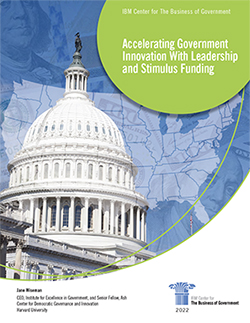
A Unique Opportunity for Government Innovation: How Leaders Can Leverage Stimulus Funding

Our Center and many others have written numerous reports about government innovation, including how new innovation roles have focused on technology, data, and digital goals. Innovation and data teams have been in place in cities for a decade, and more recently in state and federal government.
With the evolving maturity of innovation offices and digital teams comes the imperative for leaders and managers to provide pathways for these organizations to succeed and work together effectively, in terms of embracing new ideas and scaling those that prove effective beyond a prototype or pilot. The availability of a large, one-time infusion of federal funds to support state and local services and programs through the American Rescue Plan Act, the Infrastructure law, and other recent laws provides State and local leaders with a unique opportunity to collaborate with their federal partners and promote innovation that improves the lives of their people. Data and innovation teams can help government be more efficient and effective in spending stimulus funds at the state and local level in the coming years.
A new Center report, Accelerating Government Innovation With Leadership and Stimulus Funding, by Jane Wiseman -- Senior Fellow with the Harvard Kennedy School Ash Center and CEO for the Institute for Excellence in Government -- explores various ways that executives can leverage stimulus funding to incentivize success across multiple innovation and data roles, and drive forward work from those roles into digital service development and delivery. Through close examination of multiple cases in the field, the author develops a framework with specific recommendations for how leaders can drive opportunities for innovators to complement each other to the benefit of public good, including key skills or characteristics that correlate to success.
This report is intended to help leaders of current government innovation groups, including chief data officers, chief digital officers, innovation team leaders, and similar groups, to learn from successful models that they can apply directly to their operations to be more effective. Specific recommendations for managers include:
- Create teams with diverse perspectives
- Innovate by combining and borrowing from other disciplines
- Foster outsider thinking
- Allow for wonder, and wander
- Plan for persistence
- Continuously challenge the status quo
- Invest in project management skills
The report also provides lessons and recommendation for senior executives in government, such as a cabinet secretary, governor, county executive or mayor, to help them think through the possible models of effective practices to support the range of innovation roles, define success. Recommendations here include:
- Think big and create a bold vision
- Create a dedicated team tasked with embedding data and innovation skills
- Set aside some stimulus funding for innovation
- Anchor stimulus funding in data
- Foster curiosity
- Welcome ideas, and don’t reject them too quickly
- Create permission to fail
- Empower all employees to innovate
- Gather public input
- Institutionalize innovation
Jane Wiseman’s research builds on her prior work for the IBM Center, including Data-Driven Government: The Role of Chief Data Officers and Silo Busting: The Challenges and Successes of Intergovernmental Data Sharing. The report also continues the Center’s longstanding work to help drive government innovation forward, including Innovation and Emerging Technologies in Government: Keys to Success by Alan Shark, Encouraging and Sustaining Innovation in Government by Beth Noveck and Stefaan Verhulst, and The Persistence of Innovation in Government: A Guide for Innovative Public Servants by Sandford Borins.
We hope this report inspires innovators, managers, and leaders in government with a better understanding for how to capitalize on present opportunities created by major funding support in creating a better future for the people who they serve.



